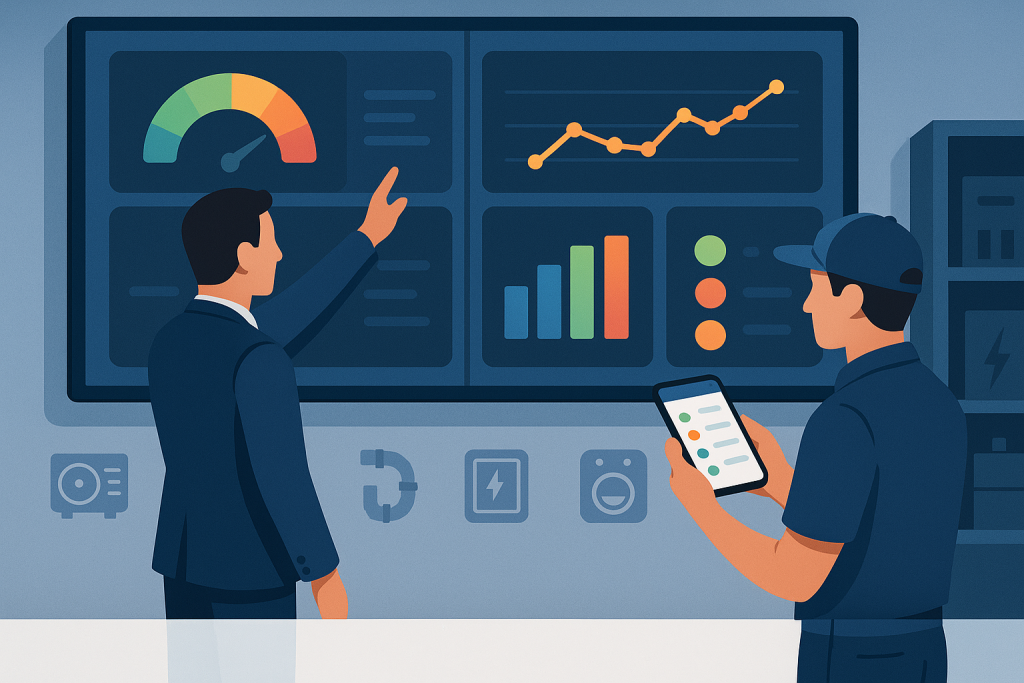By Bruce Gordon, CEO of Profit Solutions
After 38 years of studying business efficiency, I’ve discovered that home services businesses have one of the most predictable customer behavior patterns of any industry. HVAC systems fail on the hottest days, plumbing emergencies happen at the worst possible times, and electrical issues seem to occur right when you least expect them. But what if these “unexpected” problems weren’t unexpected at all?
The $1.8 Million Missed Opportunity in Home Services
Let me describe a scenario that perfectly illustrates the untapped potential in home services. Recently, I worked with an established HVAC and plumbing company with 18 technicians serving a metropolitan area of 400,000 people. They had strong customer relationships, excellent service quality, but were missing massive revenue opportunities by operating reactively instead of proactively.
Here’s what their business looked like:
- Annual service calls: 3,200 emergency and repair calls
- Preventive maintenance calls: 850 annually (21% of total calls)
- Customer database: 8,400 past customers with detailed service histories
- Seasonal staff adjustments: Hiring temporary help during peak seasons, laying off during slow periods
- Average customer frequency: 1.7 service calls over 3-year period
- Revenue per customer: $340 annually across all services
The analysis revealed staggering missed opportunities:
- Past customers with predictable needs: 6,200 customers had service histories indicating upcoming maintenance or replacement needs
- Seasonal demand patterns: Historical data showed exactly when different types of calls would spike
- Geographic service clusters: Neighborhoods with aging infrastructure showed predictable failure patterns
- Equipment lifecycle tracking: 4,100 customers had equipment approaching replacement timelines
The financial impact of this reactive approach:
- Missed preventive maintenance revenue: $1.8 million annually in preventable emergency calls that could have been scheduled maintenance
- Inefficient staffing costs: $127,000 annually in overtime and temporary labor during peak periods
- Lost customer relationships: 67% of customers went 2+ years without contact, many switching to competitors
- Suboptimal pricing: Emergency rates averaged 40% higher than planned service, but customers preferred scheduled maintenance pricing
Why Traditional Home Services Business Models Fail to Maximize Revenue

Most home services companies operate like firefighters—waiting for emergencies and responding reactively. They maintain customer databases but use them only for basic record-keeping rather than predictive business intelligence. This reactive approach misses the fundamental truth about home services: customer needs are highly predictable based on equipment age, usage patterns, seasonal factors, and historical service data.
The Reactive Revenue Trap
Traditional home services businesses generate revenue through:
- Emergency calls with high-stress, high-price scenarios
- Word-of-mouth referrals when equipment fails
- Seasonal advertising during peak demand periods
- Generic marketing to broad geographic areas
This approach creates feast-or-famine revenue cycles, customer dissatisfaction due to emergency situations, and missed opportunities for ongoing customer relationships.
The Data Goldmine Problem
Home services companies sit on goldmines of predictive data but lack systems to analyze and act on this information:
- Service history data showing equipment failure patterns
- Seasonal demand patterns that repeat annually with high accuracy
- Geographic clustering of similar homes with similar systems
- Customer behavior patterns indicating maintenance preferences and budget cycles
- Equipment manufacturer data providing expected lifecycles and maintenance schedules
Without predictive analytics, this valuable data remains unused while competitors capture market share through more sophisticated approaches.
The Customer Relationship Gap
Most home services companies have minimal ongoing contact with customers between service calls. They miss opportunities to:
- Provide proactive maintenance reminders
- Educate customers about system optimization
- Build relationships that generate referrals
- Cross-sell related services during routine visits
- Retain customers who might otherwise switch to competitors
Transform Your Home Services Business with Predictive Communication
Before implementing comprehensive predictive analytics systems, let me offer you something that can immediately improve your customer communication and service delivery: a custom AI phone agent built specifically for home services – completely FREE.
Imagine having an AI assistant that can schedule service appointments, provide emergency triage, answer common technical questions, and capture customer information for predictive analysis – all while your technicians stay focused on delivering excellent service.
🔧 Get Your Home Services AI Phone Agent:
✓ Emergency Call Triage – Identifies true emergencies and routes them immediately to available technicians
✓ Service Appointment Scheduling – Books routine maintenance and repair appointments automatically
✓ Technical Question Support – Answers common questions about HVAC, plumbing, and electrical issues
✓ Customer Information Capture – Collects data for predictive analytics and service history tracking
✓ Follow-Up Coordination – Schedules maintenance reminders and system check-ups
✓ Multi-Service Integration – Handles calls for HVAC, plumbing, electrical, and other home services
Your customers need help at all hours. Your technicians need to focus on skilled work. Your business needs predictable revenue growth.
👉 BUILD MY HOME SERVICES AI AGENT – FREE
No credit card required. Home services-trained AI ready in under 24 hours.
How Predictive Analytics AI Transforms Home Services Operations

Modern predictive analytics systems don’t just forecast when equipment might fail—they create comprehensive customer lifecycle management that transforms one-time service calls into ongoing customer relationships and predictable revenue streams.
Customer Lifecycle Prediction and Management
AI predictive systems analyze multiple data points to forecast customer needs:
- Equipment age and maintenance history to predict replacement and major repair timing
- Seasonal usage patterns combined with local weather data to forecast system stress
- Geographic clustering analysis to identify neighborhoods with similar service needs
- Customer behavior patterns to optimize communication timing and service offerings
- Economic factors that influence customer spending on home improvements and maintenance
Proactive Service Scheduling and Route Optimization
Advanced predictive systems enable:
- Automated maintenance reminder systems that contact customers before problems occur
- Seasonal preparation campaigns that prevent emergency calls during peak seasons
- Geographic route optimization that clusters preventive maintenance calls efficiently
- Capacity planning that smooths demand across seasonal variations
- Dynamic pricing strategies that encourage off-peak scheduling and preventive maintenance
Revenue Optimization Through Predictive Insights
AI systems identify and capture revenue opportunities through:
- Cross-selling analysis that identifies customers likely to need additional services
- Upselling timing optimization that presents equipment upgrades at optimal moments
- Customer retention predictions that identify at-risk customers for proactive engagement
- Market expansion opportunities in underserved geographic areas with predictable demand
- Service bundling recommendations that increase customer lifetime value
Case Study: Transforming a Regional Home Services Company
Let me walk you through a comprehensive case study that demonstrates the real-world impact of predictive analytics on home services operations:
The Company: A family-owned HVAC, plumbing, and electrical services company with 22 technicians serving suburban and rural markets, generating $4.8 million in annual revenue with strong local reputation but inconsistent growth.
The Reactive Business Model Challenges:
- 78% of revenue came from emergency calls, creating unpredictable cash flow
- Customer contact occurred only when equipment failed, missing relationship-building opportunities
- Seasonal staffing challenges with 40% revenue variation between peak and off-peak months
- Customer database contained 12,000 records but was used only for basic invoicing
- Marketing consisted of Yellow Pages ads and seasonal postcards with minimal targeting
- Average customer lifetime value was $890 over 4-year period
The Predictive Analytics AI Solution:
- Implemented comprehensive customer data analysis system with predictive modeling
- Created automated maintenance reminder campaigns based on equipment age and service history
- Deployed seasonal preparation programs targeting customers with aging systems
- Built geographic clustering system for efficient route planning and targeted marketing
- Established proactive communication systems for equipment replacement timing
- Integrated weather data with customer system information for predictive maintenance alerts
Results After 18 Months:
- Preventive maintenance calls increased from 21% to 67% of total service volume
- Revenue predictability improved with 85% of monthly revenue now scheduled in advance
- Seasonal revenue variation reduced from 40% to 12% through proactive scheduling
- Customer lifetime value increased from $890 to $2,340 over 4-year periods
- Emergency call volume reduced by 52% through preventive maintenance programs
- Overall revenue growth of 87% without adding technicians
Financial Impact:
- Preventive maintenance revenue increased by $1.6 million annually
- Reduced emergency overtime costs saved $89,000 per year
- Improved customer retention added $340,000 in recurring revenue
- Efficient routing and scheduling saved $67,000 in operational costs
- Cross-selling and upselling generated additional $290,000 annual revenue
- Total annual benefit: $2.4 million in increased revenue and cost savings
Home Services-Specific Predictive Analytics Applications

Different home services sectors benefit from specialized predictive analytics approaches:
HVAC Services
Predictive Factors: Equipment age, seasonal usage patterns, maintenance history, energy efficiency ratings, local climate data Applications: Seasonal preparation campaigns, filter replacement programs, system upgrade timing, emergency prevention strategies
Plumbing Services
Predictive Factors: Home age, pipe material, water quality, seasonal freeze patterns, previous repair locations Applications: Preventive drain cleaning, pipe replacement programs, water heater maintenance, seasonal weatherization
Electrical Services
Predictive Factors: Home electrical system age, previous service history, appliance load analysis, safety inspection data Applications: Panel upgrade recommendations, safety inspection reminders, energy efficiency improvements, code compliance updates
Multi-Service Home Maintenance
Predictive Factors: Home age, comprehensive service history, homeowner behavior patterns, neighborhood demographic data Applications: Comprehensive maintenance programs, seasonal preparation packages, home improvement timing, emergency prevention strategies
Implementation Strategy for Home Services Companies
Successful predictive analytics implementation requires understanding the unique service cycles and customer behaviors in home services:
Phase 1: Data Collection and Analysis Infrastructure (Weeks 1-4)
- Audit existing customer database and service history information
- Implement data collection systems for ongoing service calls and customer interactions
- Integrate weather data, geographic information, and demographic data sources
- Establish baseline metrics for current reactive business performance
Phase 2: Predictive Model Development (Weeks 3-8)
- Build customer lifecycle prediction models based on equipment age and service history
- Create seasonal demand forecasting systems using historical data and weather patterns
- Develop geographic clustering analysis for route optimization and targeted marketing
- Implement customer behavior analysis for communication timing and service preferences
Phase 3: Proactive Communication Systems (Weeks 6-12)
- Launch automated maintenance reminder campaigns with personalized timing
- Deploy seasonal preparation programs targeting high-risk equipment and customers
- Create customer education systems that build relationships and prevent emergencies
- Implement cross-selling and upselling recommendation engines
Phase 4: Advanced Analytics and Optimization (Months 3-6)
- Add real-time demand forecasting for dynamic staffing and inventory management
- Implement competitive analysis and market expansion opportunity identification
- Deploy advanced customer retention and lifetime value optimization systems
- Create comprehensive business intelligence dashboard for strategic decision-making
Measuring Success: Home Services Predictive Analytics KPIs

Home services companies should track these critical metrics to measure predictive analytics effectiveness:
Preventive vs. Emergency Call Ratio: Target shift from 20-30% preventive to 60-70% preventive maintenance calls.
Revenue Predictability: Measure percentage of monthly revenue scheduled in advance. Target 70-80% predictable revenue.
Customer Lifetime Value Growth: Track improvement in average customer value over time. Expect 150-300% improvement.
Seasonal Revenue Smoothing: Measure reduction in peak-to-off-peak revenue variation. Target 50-70% reduction in variation.
Customer Retention Rate: Track percentage of customers who use services again within 24 months. Expect 200-400% improvement.
Emergency Call Reduction: Measure decrease in true emergency calls through preventive maintenance. Target 40-60% reduction.
Advanced Predictive Analytics Features for Home Services
Leading home services companies are implementing sophisticated predictive capabilities:
Weather-Integrated Demand Forecasting: AI systems that combine weather predictions with customer system data to forecast service demand and optimize staffing.
Neighborhood Infrastructure Analytics: Systems that analyze entire neighborhoods to predict service needs based on home age, construction methods, and infrastructure patterns.
Equipment Manufacturer Integration: Predictive systems that incorporate manufacturer warranty data, recall information, and expected lifecycle data for precise maintenance timing.
Economic Factor Analysis: AI that considers local economic conditions, energy costs, and housing market trends to optimize service timing and pricing strategies.
Competitive Intelligence Integration: Systems that monitor competitor activity and market conditions to identify expansion opportunities and pricing optimization.
The Customer Experience Transformation

Predictive analytics fundamentally changes how customers experience home services:
Proactive Service: Customers receive maintenance reminders and seasonal preparation advice before problems occur.
Reduced Emergencies: Preventive maintenance significantly reduces stressful emergency situations and unexpected expenses.
Budget Predictability: Customers can plan and budget for home maintenance rather than facing surprise emergency costs.
Educational Relationships: Ongoing communication provides valuable home maintenance education and builds trusted advisor relationships.
Convenient Scheduling: Predictive systems offer appointment scheduling at optimal times for both customers and service providers.
The Competitive Advantage of Predictive Home Services
In home services, predictive analytics becomes a significant competitive differentiator:
Market Share Growth: Proactive customer communication captures market share from reactive competitors.
Customer Loyalty: Ongoing relationships and preventive service create strong customer retention and referral generation.
Operational Efficiency: Predictable demand enables optimal staffing, routing, and inventory management.
Premium Pricing: Preventive maintenance and trusted advisor relationships support higher pricing than emergency-only competitors.
Business Scalability: Predictable revenue and efficient operations enable sustainable growth without proportional cost increases.
Implementation Considerations for Home Services

When implementing predictive analytics, home services companies should consider:
Data Quality: Ensure accurate, complete customer and service history data for reliable predictive modeling.
Technology Integration: Plan seamless integration with existing scheduling, billing, and customer management systems.
Staff Training: Train technicians and office staff to work with predictive insights and proactive customer communication.
Customer Education: Help customers understand the value of preventive maintenance and proactive service relationships.
Compliance Considerations: Ensure predictive communication complies with relevant consumer protection and privacy regulations.
Taking Action: Your Path to Predictive Home Services Success
The home services industry is evolving from reactive emergency response to proactive customer lifecycle management. Companies that implement predictive analytics systems gain significant advantages in revenue predictability, customer satisfaction, and competitive positioning.
Your implementation strategy:
- Assess Your Data Assets: Analyze your existing customer and service data for predictive analytics potential
- Calculate Reactive Costs: Determine how much revenue you’re missing through reactive-only business models
- Plan Technology Integration: Understand how predictive systems will integrate with your existing operations
- Develop Implementation Timeline: Create a phased approach that maintains service quality during transition
- Train and Optimize: Ensure your team understands predictive insights and continuously improves based on results
Start Predicting Customer Needs Today

While you’re planning comprehensive predictive analytics systems, you can immediately improve your customer communication and data collection with a custom AI phone agent built specifically for home services professionals.
🏠 Why Home Services Companies Choose Our AI Phone Agents:
✓ 24/7 Emergency Response – Professional triage of urgent vs. routine service calls
✓ Predictive Data Collection – Captures customer information for future analytics and service planning
✓ Automated Scheduling – Books maintenance appointments and service calls efficiently
✓ Technical Support – Answers common questions about HVAC, plumbing, and electrical issues
✓ Customer Relationship Building – Maintains contact between service calls for ongoing relationships
✓ Multi-Service Coordination – Handles calls for all your service offerings in one professional system
Real Home Services Results:
- HVAC Company in Denver: Increased preventive maintenance calls by 240% through AI-assisted customer communication
- Plumbing Service in Atlanta: Reduced emergency calls by 58% while growing total revenue by 43%
- Multi-Service Company in Phoenix: Improved customer retention by 89% through proactive AI communication
Critical Home Services Business Stats:
- Customers prefer preventive maintenance by 4:1 over emergency repairs when given the choice
- Proactive home services companies achieve 67% higher customer lifetime values than reactive competitors
- Predictive maintenance reduces emergency calls by 40-60% while increasing total service revenue
👉 GET MY FREE HOME SERVICES AI PHONE AGENT
Built for home services professionals who want to transform reactive businesses into predictive success stories. Ready in under 24 hours. No credit card required.
Remember, every customer in your database represents predictable future service needs. Every piece of equipment you’ve serviced has a predictable lifecycle. Every season brings predictable challenges that you can help customers prepare for.
The home services companies that embrace predictive analytics and AI-powered customer communication now will build sustainable competitive advantages, while those that remain reactive will struggle to compete against more sophisticated, proactive competitors.
Your customers want to avoid emergencies. Your business needs predictable revenue. Your technicians deserve efficient, planned work schedules. Get all three working together with predictive analytics and AI-powered communication systems.


